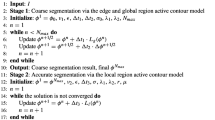Abstract
Active contours or snakes are widely used for segmentation and tracking. These techniques require the minimization of an energy function, which is generally a linear combination of a data fit term and a regularization term. This energy function can be adjusted to exploit the intrinsic object and image features. This can be done by changing the weighting parameters of the data fit and regularization term. There is, however, no rule to set these parameters optimally for a given application. This results in trial and error parameter estimation. In this paper, we propose a new active contour framework defined using probability theory. With this new technique there is no need for ad hoc parameter setting, since it uses probability distributions, which can be learned from a given training dataset.
Access this chapter
Tax calculation will be finalised at checkout
Purchases are for personal use only
Preview
Unable to display preview. Download preview PDF.
Similar content being viewed by others
References
Isard, M., Blake, A.: Active contours. Springer, Heidelberg (1998)
Liu, Y.: Automatic 3d form shape matching using the graduated assignement algorithm. Pattern Recognition 38, 1615–1631 (2005)
Kass, M., Witkin, A., Terzopoulos, D.: Snakes: active contour models. International Journal of Computer Vision, 321–331 (1988)
Tsechpenakis, G., Rapantzikos, K., Tsapatsoulis, N., Kollias, S.: A snake model for object tracking in natural sequences. Signal Processing-Image Communication 19(3), 219–238 (2004)
Charmi, M.A., Derrode, S., Ghorbel, F.: Fourier-based geometric shape prior for snakes. Pattern Recognition Letters 29(7), 897–904 (2008)
Chan, T., Vese, L.: An active contour model without edges. Scale-Space Theories in Computer Vision 1682, 141–151 (1999)
Goldenberg, R., Kimmel, R., Rivlin, E., Rudzsky, M.: Fast geodesic active contours. Ieee Transactions on Image Processing 10(10), 1467–1475 (2001)
Chan, T.F., Esedoglu, S., Nikolova, M.: Algorithms for finding global minimizers of image segmentation and denoising models. Siam Journal on Applied Mathematics 66(5), 1632–1648 (2006)
Bresson, X., Esedoglu, S., Vandergheynst, P., Thiran, J.P., Osher, S.: Fast global minimization of the active contour/snake model. Journal of Mathematical Imaging and Vision 28(2), 151–167 (2007)
Charmi, M.A., Derrode, S., Ghorbel, S.: Fourier-based geometric shape prior for snakes. Pattern Recognition Letters 29, 897–904 (2008)
Staib, L., Duncan, J.: Boundary finding with parametrcally deformable models. IEEE Transactions on Pattern Analysis and Machine Intelligence 14, 1061–1075 (1992)
Xu, C., Prince, J.: Snakes, shapes and gradient vector flow. IEEE Transactions on Image Processing 7, 359–369 (1998)
Xu, C., Yezzi, A., Prince, J.: On the Relationship between Parametric and Geometric Active Contours. In: Proc. of 34th Asilomar Conference on Signals, Systems, and Computers, vol. 34, pp. 483–489 (October 2000)
Poon, C.S., Braun, M.: Image segmentation by a deformable contour model incorporating region analysis. Physics in Medicine and Biology 42, 1833–1841 (1997)
Goobic, A., Welser, M., Acton, S., Ley, K.: Biomedical application of target tracking in clutter. In: Proc. 35th Asilomar Conference on Signals, Systems and Computers, vol. 1, pp. 88–92 (2001)
Tsechpenakis, G., Rapantizikos, K., Tsapatsoulis, N., Kollias, S.: A snake model for object tracking in natural sequences. Signal Processing: Image Communication 19, 219–238 (2004)
Shireen, Khaled, Sumaya: Moving Object Detection in Spatial Domain using Background Removal Techniques - State-of-Art. Recent Patents on Computer Science 1, 32–34 (2008)
Author information
Authors and Affiliations
Editor information
Editors and Affiliations
Rights and permissions
Copyright information
© 2011 Springer-Verlag Berlin Heidelberg
About this paper
Cite this paper
De Vylder, J., Ochoa, D., Philips, W., Chaerle, L., Van Der Straeten, D. (2011). Leaf Segmentation and Tracking Using Probabilistic Parametric Active Contours. In: Gagalowicz, A., Philips, W. (eds) Computer Vision/Computer Graphics Collaboration Techniques. MIRAGE 2011. Lecture Notes in Computer Science, vol 6930. Springer, Berlin, Heidelberg. https://doi.org/10.1007/978-3-642-24136-9_7
Download citation
DOI: https://doi.org/10.1007/978-3-642-24136-9_7
Publisher Name: Springer, Berlin, Heidelberg
Print ISBN: 978-3-642-24135-2
Online ISBN: 978-3-642-24136-9
eBook Packages: Computer ScienceComputer Science (R0)




